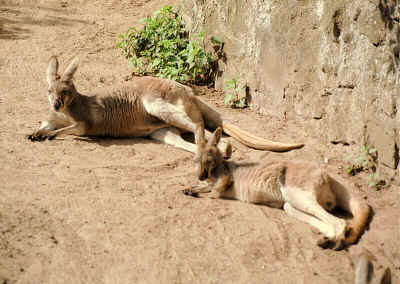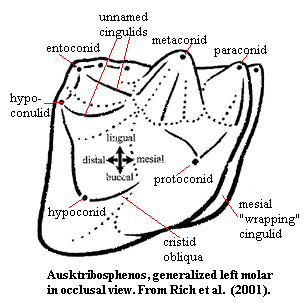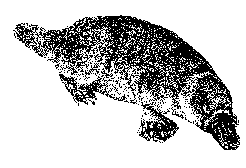 paragraphs of text are not inserted here, the images won't look right on the page. Thus I am compelled by the limitations of my software to supply a bit of background.
paragraphs of text are not inserted here, the images won't look right on the page. Thus I am compelled by the limitations of my software to supply a bit of background. | Mammalia | ||
| The Vertebrates | Mammalia |
| Vertebrates Home | Vertebrate | Vertebrate |
Abbreviated Dendrogram
Mammaliformes
│
└─Mammalia
├─Australosphenida
│ ├─Ausktribosphenidae
│ └─Monotremata
└─┬─Triconodonta
└─┬─Spalacotheroidea
└─Cladotheria
├─Dryolestoidea
└─Theria
│
├─Metatheria
└─Eutheria |
Contents
Overview |
This is a "show & tell" essay. It requires little of the usual blathering. The pictures tell the whole story. In fact, I will not even use labels, lest they get in the way of the simple visual impact of the images themselves.
To the right are three detailed images of Bishops whitmorei, p4-m1 in lingual, occlusal & buccal views, extracted from Rich et. al. (2001). More precisely, they are adapted from images rashly given by one of those authors to a nameless individual with execrable judgment, who sent them to me. In customary fashion, I have betrayed his trust, defaced the images, and dumped these debased products on the public domain for my own evil purposes. Although the pictures tell their own story, a few words of explanation and context are in order. More to the point, if a few  paragraphs of text are not inserted here, the images won't look right on the page. Thus I am compelled by the limitations of my software to supply a bit of background.
paragraphs of text are not inserted here, the images won't look right on the page. Thus I am compelled by the limitations of my software to supply a bit of background.
A few years ago, Dr. Thomas H. Rich described an Australian mammal named Ausktribosphenos from the Middle Cretaceous of Victoria. The description caused a bit of a stir: not just because it was impossible to pronounce, but because Dr. Rich asserted that the critter was a placental mammal. Middle Cretaceous placentals are a bit thin on the ground in any part of the world, and they weren't supposed to be on Gondwanan soil at all. Placentals, like so many Ivy League scholars, are supposed to originate only from select Northern localities, from which they spread out to enlighten the rest of the Earth. So, the announcement of an early Australian placental did not -- to say the least -- meet with universal acceptance. Most significantly, a coalition of well-known mammalogists suggested that Dr. Rich's discovery wasn't a placental, and wasn't a tribosphenic mammal at all, but was rather some failed monotreme cousin which had independently and accidentally evolved a (probably inferior) copy of the classic Northern tribosphenic molar. Luo et al. (2001a).
 Suspiciously, each of these critics was him- or herself a Northern placental mammal; whereas Dr. Rich and his lot were all Australians -- Gondwanans to the bone, so to speak. I have elsewhere had occasion to remark on the dangers of arousing the normally placid Australians. They are prone to directness and alarming fits of energy. Dr. Rich apparently determined that if those Laurasian types didn't like his last bloody fossil, he'd grab a crew and get themselves an even better one. Bishops whitmorei was the result.
Suspiciously, each of these critics was him- or herself a Northern placental mammal; whereas Dr. Rich and his lot were all Australians -- Gondwanans to the bone, so to speak. I have elsewhere had occasion to remark on the dangers of arousing the normally placid Australians. They are prone to directness and alarming fits of energy. Dr. Rich apparently determined that if those Laurasian types didn't like his last bloody fossil, he'd grab a crew and get themselves an even better one. Bishops whitmorei was the result.
However, at this point, we will leave this story. Not only have I inserted enough text to justify the images, but the point of the essay has nothing to do with placentas vel non. The real point is that Bishops has an unprecedented six premolars which grade evenly from simple dental prongs to a fully molariform condition. The opportunity, or temptation, to view this series as a developmental or evolutionary gradient is unique. It may be leading us into error, but the possibility exists that we are actually seeing, courtesy of a developmental accident, a sort of stop-motion view of molar evolution.
 Some of the views have been reversed so that the progression is always from left to right. Watch how the (red) paraconid arises from a delamination of the mesial cingulid. The (blue) metaconid, by contrast, pinches off from the (uncolored) protoconid. The (green) hypoconid begins as a delamination of the cingulid, like the paraconid, but then pushes buccally, leaving behind a transversely wide basin, the talonid. This actually distorts the shape of the m1 molar, relative to the p6, and causes a noticeable mesial tilt in the m1 protoconid as it is displaced by the advancing hypoconid -- just as if someone had reached in and pushed the incipient hypoconid outwards (bucally) on the tooth. Finally, the (yellow) entoconid and related structures arise by secondary overgrowth of the linguodistal cingulum as the hypoconid moves out of the way.
Some of the views have been reversed so that the progression is always from left to right. Watch how the (red) paraconid arises from a delamination of the mesial cingulid. The (blue) metaconid, by contrast, pinches off from the (uncolored) protoconid. The (green) hypoconid begins as a delamination of the cingulid, like the paraconid, but then pushes buccally, leaving behind a transversely wide basin, the talonid. This actually distorts the shape of the m1 molar, relative to the p6, and causes a noticeable mesial tilt in the m1 protoconid as it is displaced by the advancing hypoconid -- just as if someone had reached in and pushed the incipient hypoconid outwards (bucally) on the tooth. Finally, the (yellow) entoconid and related structures arise by secondary overgrowth of the linguodistal cingulum as the hypoconid moves out of the way.
I should add that this line of molar maundering is not endorsed by Dr. Rich -- or anyone else, for that matter. However, the visual story is dramatic, direct, and clear. It may be totally wrong, but bears careful watching. If it is at all correct, Bishops and the Ausktribosphenids may provide a definitive Rosetta Stone for mammalian cusp homologies. APW 040806.
 Mammalia: Crown group mammals, i.e. Knuckles the Echidna + Suleiman the Magnificent.
Mammalia: Crown group mammals, i.e. Knuckles the Echidna + Suleiman the Magnificent.
from the Middle Jurassic
Symmetrodonta : Kuehneotheriidae + * : Australosphenida + (Triconodonta + (Spalacotheroidea + Cladotheria)).
Characters: $? dentary condyle above the postcanine alveolar level [L+01]; $? masseteric fossa ventral ridge present [L+01]; $ overhanging medial ridge above the post dentary trough absent [L+01]; $ angular process of the dentary absent [L+01]; "reversed triangle" molar pattern (primitive); $? molar interlocking absent [L+01] (reversal -- doubtful); lower teeth: $? ultimate premolar cusp a with symmetrical outline (lateral view) [L+01]; $ ultimate premolar cingulid cuspule 'd' present (= hypoconulid?) [L+01]; $? acute trigonid angle with b/paraconid positioned more lingually [L+01]; $ b/paraconid & c/metaconid roughly equal in height [L+01]; $? well-advanced jaw rotation during the occlusion [L+01].
Note: those venturing further into mammals may wish to refer to the discussion of Molars.
Links: Holotheria; Class Mammalia ADW, with really good anatomical resources); Mammalia ToL); Open Directory - Science- Biology- Flora and Fauna- Animalia- ...; The Hall of Mammals; Class Mammalia very basic); Mammalia, Mammals Calif. diversity, with natural history information); Bestimmungsübungen an Voegeln und Saeugern; APUS.RU | Класс ·Млекопитающие - Mammalia; MGI - Gene Ontology Browser; Mammalia collection of SZMN, Novosibirsk, Russia Great site, now returned after a brief absence in 2003); Class Mammalia awkwardly designed, but useful site); Mammals (Mammalia) - MavicaNET; 动物搜索 in English).
References: Luo et al. (2001a) [L+01]. APW 040806.
 Australosphenida: defined as Ambondro + monotremes [L+01]. Gondwanan mammaliforms with convergently derived tribosphenic molars. Redefined [K+02] as monotremes > Shuotherium. [2] Ambondro, Asfaltomylos.
Australosphenida: defined as Ambondro + monotremes [L+01]. Gondwanan mammaliforms with convergently derived tribosphenic molars. Redefined [K+02] as monotremes > Shuotherium. [2] Ambondro, Asfaltomylos.
Range: from the Middle Jurassic (Bathonian) of Africa?, Madagascar, South America & Australia.
Phylogeny: Mammalia : (Triconodonta + (Spalacotheroidea + Cladotheria)) + * : Ausktribosphenidae + Monotremata.
Characters: premolars molariform, with distinctive trigonid pattern [L+01]; premolars with prominent lingual cingulid [L+01]; shelf-like mesial cingulid wrapping around mesiolingual corner of tooth [K+02]; $ last lower premolar transversely wide at distal end [L+01]; $ last lower premolar lacks trigonid, resulting in fully "triangulated" trigonid [K+01] [1]; $ last lower premolar has continuous distal cingulid [L+01]; $? 3 molars or fewer [L+01]; $ b/metaconid and a/protoconid subequal in height [L+01]; "twinned" paraconid & metaconid (?) [L+01]; well-developed lingual cusp on cingulid [L+01]; $? entoconid present and distinctive [L+01]; $ hypoconulid positioned distal and median in talonid [L+01]; $ talonid broad [L+01]; $? m2 talonid wider than or equal to width of trigonid [L+01]; $ shelf-like mesial cingulid wrapping around the mesiolingual corner of the molar [L+01]; $ ectoflexid very deep (60% of the talonid width) [L+01]; post-dentary trought retained in on dentary [L+01].
Note: [1] That is, "the trigonid is transversely broad and semi-molariform, with well-developed paraconid and metaconid arranged in a distinctly triangulated fashion with the protoconid." This characteristic is shared with Shuotherium (which lacks a "pseudotalonid") and, according to [K+01] is unique among Mesozoic mammals. [2] [K+01] consider "Yinotheria" to be the appropriate term for the clade Knuckles the Echidna > Suleiman the Magnificent.
Links: MESOZOIC MAMMALS; SHUOTHERIIDAE & AUSTRALOSPHENIDA, an internet ... Best on the Web); The first Jurassic mammal from South America a South American australosphenid); Non-reptilian life in Mesozoic Australia; Australophenida Mikko's Phylogeny); Abstract List abstracts of many of Dr. Z-X Luo's papers!); J408_4c 53..57 .pdf file of [L+01]).
References: Kielan-Jaworowska et al. (2002) [K+02]; Luo et al. (2001a) [L+01]; Rich et al. 2001). APW 040806.
 Ausktribosphenidae: [R+01]. An extinct group of Australian tribosphenic mammals which are, or have a striking dental similarity to, placental mammals. Ausktribosphenos, Bishops.
Ausktribosphenidae: [R+01]. An extinct group of Australian tribosphenic mammals which are, or have a striking dental similarity to, placental mammals. Ausktribosphenos, Bishops.
Range: mK of Aus.
Phylogeny: Australosphenida : Monotremata + *.
Characters: post-dentary trough present in Ausktribosphenos; 6 lower premolariform teeth, the last two of which are very molariform [R+01]; unnamed cristids 3 and 4 on many but not all lower molar talonids [R+01].
References: Luo et al. (2002) [L+02], Rich et al. 2001) [R+01] APW 040806.
Monotremata: Ornithorhynchos (platypus), Steropodon, Tachyglossus (echidna).
fr lwK of Aus & SAm.
Teeth absent in adults; molars have two transverse ridges, perhaps not comparable to trigon - trigonid; dentary slender, with low or absent coronoid process; jaw opened with detrahens muscle (Vth nerve only); post-dentary bones fully incorporated into ear, but external auditory meatus lies at posterior base of jaw;  cochlea coiled [H+97]; jugal reduced or absent; anterior extensions of petrosal cover much of therian alisphenoid area; skull bones fuse early in life; cervical ribs present; pectoral girdle primitive with strong ventral elements (both coracoids, clavicle & interclavicle); interclavicle rigidly bound to clavicles [H+97]; scapula robust and provides rigid connection; humerus remains horizontal to substrate; pelvic girdle similar to therians, but with widely angled anterolaterally directed epipubic bones; median spurs on ankles; metabolic rate lower than therian mammals; electrosensory system in rostrum; lack effective evaporative cooling; single urogenital sinus with cloaca; scrotum absent; oviparous, but egg is retained for some time in the uterus and actively provided nutrients by mother; egg not calcified; lactation, but nipples absent; prolonged brooding; low reproduction rate, with individuals very long-lived; all living species fossorial (platypus is aquatic & fossorial).
cochlea coiled [H+97]; jugal reduced or absent; anterior extensions of petrosal cover much of therian alisphenoid area; skull bones fuse early in life; cervical ribs present; pectoral girdle primitive with strong ventral elements (both coracoids, clavicle & interclavicle); interclavicle rigidly bound to clavicles [H+97]; scapula robust and provides rigid connection; humerus remains horizontal to substrate; pelvic girdle similar to therians, but with widely angled anterolaterally directed epipubic bones; median spurs on ankles; metabolic rate lower than therian mammals; electrosensory system in rostrum; lack effective evaporative cooling; single urogenital sinus with cloaca; scrotum absent; oviparous, but egg is retained for some time in the uterus and actively provided nutrients by mother; egg not calcified; lactation, but nipples absent; prolonged brooding; low reproduction rate, with individuals very long-lived; all living species fossorial (platypus is aquatic & fossorial).
Links: Skulls Unlimited International Inc.; Introduction to the Monotremata; Yahoo! Monotremes; The platypus is not a rodent (abstract); The sensory world of the platypus (abstract); Introduction to Monotremata; Platypus (Ornithorhynchus anatinus) Online Resource Guide: BIBLIOGRAPHY; ! Rainforest Echidna ! Tropical Rainforest, Far North Queensland Australia; Duck-Billed Platypus (Ornithorhynchus anatinus); Comparative Mammalian Brain Collections: MONOTREMATA; Monotremata; Monotremes - Order Monotremata; Mammalogy Image Archives: Monotremata. There are a very large number of very good sites. This is, at best, a random sample.
References: Hu et al. (1997) [H+97]. APW 040806.
checked ATW060217